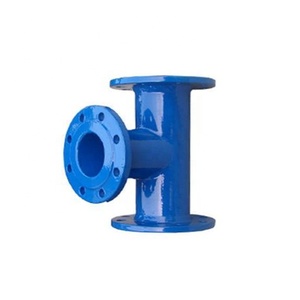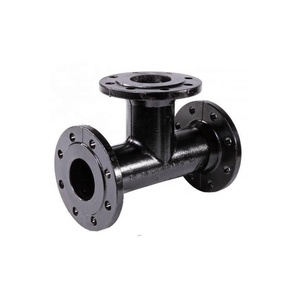(1210 products available)



























































































































































A cast-iron Y-pipe fitting is a plumbing product that is commonly utilized in drainage, waste, and vent systems. Thanks to the shape of the letter "Y," cast-iron Y fittings easily connect three plumbing lines at once. Cast-iron Y fittings come in various configurations to suit multiple installation requirements.
The most common types include the following:
Standard Y pipe fittings
Standard Y pipe fittings are bell-shaped fixtures that connect two pipes to a larger main line. They allow liquids and solids to flow from one branch through the other into the main drainage line. Standard Y fittings are often found in horizontal piping systems.
Sock Y pipe fittings
As the name suggests, sock Y fittings have a socket or bell end on one side and a branch outlet on the other. The socket end fits over the mainline pipe, while the branch outlet is welded or screwed onto the smaller branch pipe. Sock Y fittings facilitate angled connections between multiple pipes.
Street Y pipe fittings
Street Y fittings differ from standard fittings by including one male threaded end. This allows direct connection to threaded pipes without additional couplings. The male threaded portion is typically shorter than the female ends.
Oversized Y pipe fittings
Oversized Y fittings are cast larger than standard fittings to accommodate bigger piping systems. The increased size allows for greater liquid and solid waste removal capacity in commercial and industrial settings.
Due to their durability and strength properties, cast-iron Y-pipe fittings have many industrial applications. Some notable installations include the following:
Wastewater treatment plants
In wastewater treatment plants, there is a need for fittings that can withstand harsh chemical exposure. The cast iron Y pipe fittings can handle these chemicals while maintaining structural integrity. That is why they are commonly used in piping systems to direct the flow of water and waste through various treatment processes.
Agricultural irrigation systems
Farmers use the Y fittings in irrigation systems to distribute water evenly across fields. The fittings allow for the branching of main waterlines to multiple irrigation channels. This ensures efficient water supply for crop health and agriculture production maintenance.
Mining operations
Mining companies extensively use Y-pipe fittings in mine ventilation systems. The fittings help branch out ventilation ducts to different areas of the mine. This ensures an adequate air supply for miners while keeping the mine free from toxic gas accumulation.
Manufacturing plants and factories
Manufacturing plants and factories use piping systems that carry not just water but also steam, chemicals, and gases. Cast iron Y-pipe fittings are thus preferred in these settings, as they are both inexpensive and durable, facilitating branching in these heavy-duty piping systems.
Overview of some of the salient features of cast-iron Y-pipe fittings include:
Durable material construction
Cast iron is exceptionally durable. While heavy, it provides excellent resistance to corrosion, rust, fire, and impact. This ensures a long lifespan even in the most demanding environments of industrial applications.
Rugged build design
Unlike PVC and plastic pipe fittings, cast iron Y fittings can withstand extremely high temperatures exceeding 1000 degrees Fahrenheit. They can also handle significant pressures, making them ideal for steam and gas transfer applications.
Sound attenuation
The dense material of cast-iron Y-fittings effectively dampens vibrations and reduces noise transmissions along the piping system. This is particularly useful in plumbing and HVAC applications where excessive sound can be disruptive.
Compatibility with heavyweight pipes
Cast iron Y-pipe fittings are commonly used with other cast iron pipes to create a durable, unified piping system. Their weight and rigidity provide stability for heavyweight vertical plumbing installations in buildings.
Here is how to install cast iron Y-pipe fittings correctly:
Preparation
Beware of the mainline's direction of flow before disconnecting the old fitting. Ensure the branch pipe and mainline are also properly cleaned and free of debris. Before installation, coat the inside of the Y-fitting with lubricant so that the connected pipes have an easier time being fitted into place.
Fitting the branches
Insert each end of the Y-fitting into the branch pipes after inserting the lubricant. Ensure the branch pipe is aligned and securely connected to the fitting. Clamp or weld the joints as required by the existing system's specifications.
Connecting to the mainline
Insert the center socket or branch outlet of the Y-fitting into the mainline pipe after the branch pipes are connected. Mainline pipe's end should be belled or threaded to match the Y-fitting. Clamp, screw, or weld the fitting securely onto the mainline.
Final adjustments and testing
Once installation is complete, inspect all joints for secure fittings. With the fixture's ventilation open, test for leaks by running water or air through the system. This ensures no leaks and that proper flow direction and functionality of the Y-pipe fittings are achieved.
Proper maintenance and repairs of cast iron Y-pipe fittings will help extend their lifespan. Here's the rundown on how to do fitting maintenance and repairs:
Regular inspections
Inspect the pipe fittings regularly for corrosion, rust, leaks, or damage. Look out for moisture accumulation and vegetation growth, as they can corrode pipes. Conduct the inspection visually when the system is not in use or through pressure and flow monitoring, as any irregularities can indicate deterioration.
Rust/corrosion prevention
Since most Y fittings are exposed to moisture, adequately dry them before leaving them to prevent rusting. Apply lubricant, paint, or wax coating to hinder moisture exposure. For buried fittings, ensure the area around them is dry and free from stagnant water.
Leaks identification
Keep an eye out for sudden pressure drops or constant dampness around the fitting, as they can indicate leaky seams. Address leaks immediately to prevent wastewater contamination. Small leaks can be sealed using joint sealants, repair tape, or epoxy putty. Larger ones may require replacing the fitting entirely.
Repairing damaged fittings
Pitting, cracking, or breaks in the fitting may necessitate complete replacement in most cases. However, in some extreme cases, damaged cast iron pipe fittings can be repaired using welding, epoxy resin, or installing a pipe repair clamp. This ultimately depends on the extent of the damage.
Replacement criteria
If the Y-fitting is extensively rusted or there's repeated leak issues, it may need complete replacement. When replacing fittings, ensure the new one matches the existing system's size, material, and specifications to maintain uniformity and functionality in the plumbing system.
While sourcing a flexible exhaust Y pipe, here are some quality indicators to evaluate:
Material quality
Cast iron's solidity makes it ideal for safely handling highly pressurized fluids. Its added weight also dampens noise. On the other hand, stainless steel is strong against rust and leaks and will not corrode over time.
Precision manufacturing
Accurate sizing is paramount, as improperly sized joints lead to leaks and reduced efficiency. So, only go for Y fittings with precision-engineered sockets and branches for a secure fit with minimal gaps.
Surface integrity
A smooth inner surface limits residue buildup and clogs. Conversely, excessive roughness weakens flow and increased pressure. On the exterior, uniformly applied coatings prevent rust and offer protection.
Testing and verification
Cast-iron Y fittings undergo pressure tests to confirm their competence in handling designated pressures without deformations. Such fittings often bear certification tags from credible agencies to signify they meet plumbing codes.
Here are some safety measures to observe:
Installation precautions
When installing the Y fitting, use appropriate seals or thread tape on the threaded ends to avert gas escapes. Don't over-tighten joints, as this will crack cast iron. Deep breathes and work in well-ventilated areas to prevent accumulation of exhaust fumes from suffocating oneself.
Proper tools
Only use torque wrenches to tighten pipes to manufacturer-recommended torque. Employ expert cutting tools to eliminate sharp edges on the mainline that may result in slicing someone by accident.
Handling heavy materials carefully
Y fittings cast from iron are quite weighty. Therefore, bear the load from its center; never drag it, as one's balance can easily tip, causing falls with injury. Strategically place Y fittings to avoid accidentally kicking them in the line path.
Routine checks
Regularly check installed Y pipe fittings for rust, which compromises structural strength and leads to collapse. Inspect for leaks and fix immediately to prevent slips and falls. Also, close off areas with disabled exhausts susceptible to exhaust intrusion.
A1. Cast iron Y-pipe fittings can last over 50 years when properly maintained. However, their lifespan will reduce if exposed to more moisture, vegetation, and debris, which fosters rust and corrosion. Regularly preventing rust, sealants, and maintenance will extend cast iron Y fitting longevity.
A2. The Uniform Plumbing Code (UPC) permits the use of cast iron Y fittings for drainage in buildings. Likewise, The International Plumbing Code has similar provisions. However, local codes may designate additional requirements based on climate, rainfall, and geography. Therefore, always check local regulations before installation.
A3. To prevent corrosion in buried Y fittings, ensure the environment around them is dry and free from standing water. Then apply a thick coating of petroleum jelly or asphalt to the fittings to create a barrier between them and oxygen. Install them further away from moist plants. Corrosion-resistant stainless steel fittings can also be used.
A4. Yes, cast iron Y pipe fittings are good for outdoor sewer lines due to their strength and rust resistance. The Y-fitting integrates seamlessly with cast iron pipe to create an unyielding sewer line that withstands pressure, soil movement, and weather elements for many years.
A5. Yes, to install a Y fitting into a plastic pipe, the branch outlet and mainline will have to be connected using either a mechanical coupling or glued solvent cement. The methods serve to securely integrate the cast iron Y fitting with PVC or ABS plastic pipelines.